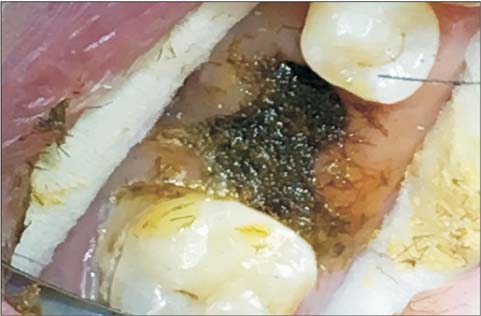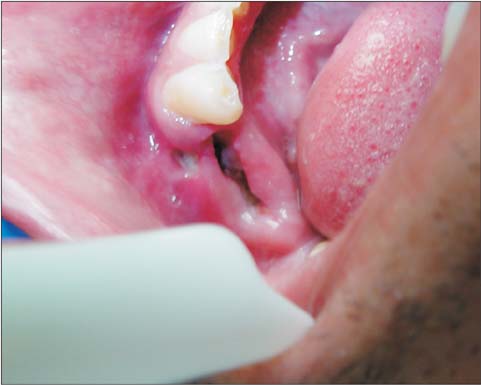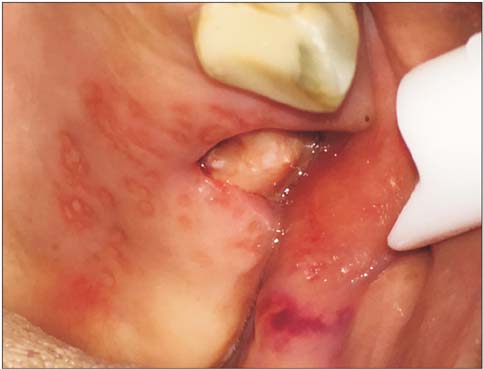J Korean Assoc Oral Maxillofac Surg.
2018 Apr;44(2):52-58. 10.5125/jkaoms.2018.44.2.52.
Dry Socket Etiology, Diagnosis, and Clinical Treatment Techniques
- Affiliations
-
- 1Private Practice, Manalapan, NJ, USA. mamounjo@gmail.com
- KMID: 2410580
- DOI: http://doi.org/10.5125/jkaoms.2018.44.2.52
Abstract
- Dry socket, also termed fibrinolytic osteitis or alveolar osteitis, is a complication of tooth exodontia. A dry socket lesion is a post-extraction socket that exhibits exposed bone that is not covered by a blood clot or healing epithelium and exists inside or around the perimeter of the socket or alveolus for days after the extraction procedure. This article describes dry socket lesions; reviews the basic clinical techniques of treating different manifestations of dry socket lesions; and shows how microscope level loupe magnification of 6× to 8× or greater, combined with co-axial illumination or a dental operating microscope, facilitate more precise treatment of dry socket lesions. The author examines the scientific validity of the proposed causes of dry socket lesions (such as bacteria, inflammation, fibrinolysis, or traumatic extractions) and the scientific validity of different terminologies used to describe dry socket lesions. This article also presents an alternative model of what causes dry socket lesions, based on evidence from dental literature. Although the clinical techniques for treating dry socket lesions seem empirically correct, more evidence is required to determine the causes of dry socket lesions.
Keyword
Figure
Cited by 1 articles
-
Classification of the journal category “oral surgery” in the Scopus and the Science Citation Index Expanded: flaws and suggestions
Seong-Gon Kim
J Korean Assoc Oral Maxillofac Surg. 2019;45(4):186-191. doi: 10.5125/jkaoms.2019.45.4.186.
Reference
-
1. Bowe DC, Rogers S, Stassen LF. The management of dry socket/alveolar osteitis. J Ir Dent Assoc. 2011–2012; 57:305–310.2. Blum IR. Contemporary views on dry socket (alveolar osteitis): a clinical appraisal of standardization, aetiopathogenesis and management: a critical review. Int J Oral Maxillofac Surg. 2002; 31:309–317.
Article3. Taberner-Vallverdú M, Nazir M, Sánchez-Garcés MÁ, Gay-Escoda C. Efficacy of different methods used for dry socket management: a systematic review. Med Oral Patol Oral Cir Bucal. 2015; 20:e633–e639.4. Daly B, Sharif MO, Newton T, Jones K, Worthington HV. Local interventions for the management of alveolar osteitis (dry socket). Cochrane Database Syst Rev. 2012; 12:CD06968.
Article5. Nitzan DW. On the genesis of “dry socket”. J Oral Maxillofac Surg. 1983; 41:706–710.
Article6. Birn H. Etiology and pathogenesis of fibrinolytic alveolitis (“dry socket”). Int J Oral Surg. 1973; 2:211–263.
Article7. Birn H. Bacteria and fibrinolytic activity in “dry socket”. Acta Odontol Scand. 1970; 28:773–783.
Article8. Birn H. Fibrinolytic activity of normal alveolar bone. Acta Odontol Scand. 1971; 29:141–153.
Article9. Birn H. Fibrinolytic activity in “dry socket”. Acta Odontol Scand. 1970; 28:37–58.
Article10. Colby RC. The general practitioner's perspective of the etiology, prevention, and treatment of dry socket. Gen Dent. 1997; 45:461–467. quiz 471-2.11. Olurotimi AO, Gbotolorun OM, Ibikunle AA, Emeka CI, Arotiba GT, Akinwande JA. A comparative clinical evaluation of the effect of preoperative and postoperative antimicrobial therapy on postoperative sequelae after impacted Mandibular third molar extraction. J Oral Maxillofac Res. 2014; 5:e2.12. Lee JY, Do HS, Lim JH, Jang HS, Rim JS, Kwon JJ, et al. Correlation of antibiotic prophylaxis and difficulty of extraction with postoperative inflammatory complications in the lower third molar surgery. Br J Oral Maxillofac Surg. 2014; 52:54–57.
Article13. Reekie D, Downes P, Devlin CV, Nixon GM, Devlin H. The prevention of ‘dry socket’ with topical metronidazole in general dental practice. Br Dent J. 2006; 200:210–213.
Article14. Freudenthal N, Sternudd M, Jansson L, Wannfors K. A double-blind randomized study evaluating the effect of intra-alveolar chlorhexidine gel on alveolar osteitis after removal of mandibular third molars. J Oral Maxillofac Surg. 2015; 73:600–605.
Article15. Abu-Mostafa NA, Alqahtani A, Abu-Hasna M, Alhokail A, Aladsani A. A randomized clinical trial compared the effect of intraalveolar 0.2% Chlorohexidine bio-adhesive gel versus 0.12% Chlorohexidine rinse in reducing alveolar osteitis following molar teeth extractions. Med Oral Patol Oral Cir Bucal. 2015; 20:e82–e87.16. Ren YF, Malmstrom HS. Effectiveness of antibiotic prophylaxis in third molar surgery: a meta-analysis of randomized controlled clinical trials. J Oral Maxillofac Surg. 2007; 65:1909–1921.
Article17. Meechan JG, Macgregor ID, Rogers SN, Hobson RS, Bate JP, Dennison M. The effect of smoking on immediate post-extraction socket filling with blood and on the incidence of painful socket. Br J Oral Maxillofac Surg. 1988; 26:402–409.
Article18. Abu Younis MH, Abu Hantash RO. Dry socket: frequency, clinical picture, and risk factors in a palestinian dental teaching center. Open Dent J. 2011; 5:7–12.
Article19. Haraji A, Rakhshan V. Single-dose intra-alveolar chlorhexidine gel application, easier surgeries, and younger ages are associated with reduced dry socket risk. J Oral Maxillofac Surg. 2014; 72:259–265.
Article20. Medcalf RL. Fibrinolysis, inflammation, and regulation of the plasminogen activating system. J Thromb Haemost. 2007; 5 Suppl 1. 132–142.
Article21. Serratì S, Margheri F, Bruschi S, D'Alessio S, Pucci M, Fibbi G, et al. Plasminogen activators and inhibitor type-1 in alveolar osteitis. Eur J Oral Sci. 2006; 114:500–503.
Article22. Berri F, Rimmelzwaan GF, Hanss M, Albina E, Foucault-Grunenwald ML, Lê VB, et al. Plasminogen controls inflammation and pathogenesis of influenza virus infections via fibrinolysis. PLoS Pathog. 2013; 9:e1003229.
Article23. Syrovets T, Lunov O, Simmet T. Plasmin as a proinflammatory cell activator. J Leukoc Biol. 2012; 92:509–519.
Article24. Li Q, Laumonnier Y, Syrovets T, Simmet T. Plasmin triggers cytokine induction in human monocyte-derived macrophages. Arterioscler Thromb Vasc Biol. 2007; 27:1383–1389.
Article25. Moore EE, Moore HB, Gonzalez E, Chapman MP, Hansen KC, Sauaia A, et al. Postinjury fibrinolysis shutdown: rationale for selective tranexamic acid. J Trauma Acute Care Surg. 2015; 78:6 Suppl 1. S65–S69.26. Orsi FA, Angerami RN, Mazetto BM, Quaino SK, Santiago-Bassora F, Castro V, et al. Reduced thrombin formation and excessive fibrinolysis are associated with bleeding complications in patients with dengue fever: a case-control study comparing dengue fever patients with and without bleeding manifestations. BMC Infect Dis. 2013; 13:350.
Article27. van Herrewegen F, Meijers JC, Peters M, van Ommen CH. Clinical practice: the bleeding child. Part II: disorders of secondary hemostasis and fibrinolysis. Eur J Pediatr. 2012; 171:207–214.28. Chapin JC, Hajjar KA. Fibrinolysis and the control of blood coagulation. Blood Rev. 2015; 29:17–24.
Article29. Halabí D, Escobar J, Muñoz C, Uribe S. Logistic regression analysis of risk factors for the development of alveolar osteitis. J Oral Maxillofac Surg. 2012; 70:1040–1044.
Article30. Goga Y, Chiba M, Shimizu Y, Mitani H. Compressive force induces osteoblast apoptosis via caspase-8. J Dent Res. 2006; 85:240–244.
Article31. Matsui H, Fukuno N, Kanda Y, Kantoh Y, Chida T, Nagaura Y, et al. The expression of Fn14 via mechanical stress-activated JNK contributes to apoptosis induction in osteoblasts. J Biol Chem. 2014; 289:6438–6450.
Article32. Nettelhoff L, Grimm S, Jacobs C, Walter C, Pabst AM, Goldschmitt J, et al. Influence of mechanical compression on human periodontal ligament fibroblasts and osteoblasts. Clin Oral Investig. 2016; 20:621–629.
Article33. Hu K, Wang C, Zhang X. High pressure may inhibit periprosthetic osteogenesis. J Bone Miner Metab. 2010; 28:289–298.
Article34. Delvaeye M, Conway EM. Coagulation and innate immune responses: can we view them separately. Blood. 2009; 114:2367–2374.
Article35. Bonnar J. Coagulation effects of oral contraception. Am J Obstet Gynecol. 1987; 157:1042–1048.
Article36. Parthasarathi K, Smith A, Chandu A. Factors affecting incidence of dry socket: a prospective community-based study. J Oral Maxillofac Surg. 2011; 69:1880–1884.
Article37. Torres-Lagares D, Serrera-Figallo MA, Romero-Ruíz MM, Infante-Cossío P, García-Calderón M, Gutiérrez-Pérez JL. Update on dry socket: a review of the literature. Med Oral Patol Oral Cir Bucal. 2005; 10:81–85.38. Hamasha AA, Al-Khateeb T, Darwazeh A. Prevalence of dilaceration in Jordanian adults. Int Endod J. 2002; 35:910–912.
Article39. Malcić A, Jukić S, Brzović V, Miletić I, Pelivan I, Anić I. Prevalence of root dilaceration in adult dental patients in Croatia. Oral Surg Oral Med Oral Pathol Oral Radiol Endod. 2006; 102:104–109.
Article40. Colak H, Bayraktar Y, Hamidi MM, Tan E, Colak T. Prevalence of root dilacerations in Central Anatolian Turkish dental patients. West Indian Med J. 2012; 61:635–639.41. Crawford JY. Dry socket. Dental Cosmos. 1896; 38:929–931.
- Full Text Links
- Actions
-
Cited
- CITED
-
- Close
- Share
- Similar articles
-
- Platelet rich fibrin in the management of established dry socket
- Common risk factors for postoperative pain following the extraction of wisdom teeth
- Current Trends in the Recognition and Treatment of Dry Eye: A Survey of Ophthalmologists
- Angiogenesis and the prevention of alveolar osteitis: a review study
- Anophthalmic Socket Reconstruction






